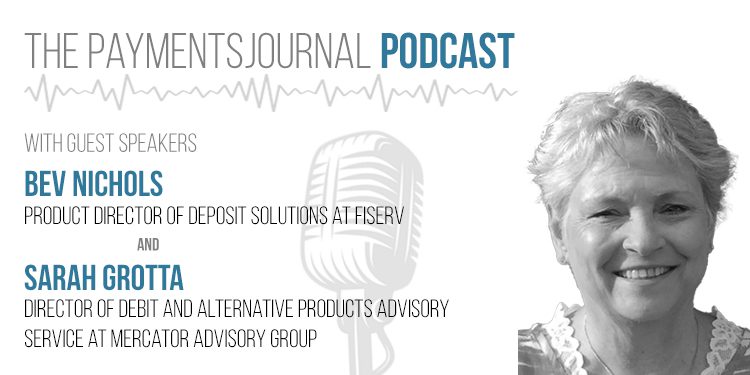With the unprecedented rise in fraudulent activity financial institutions and their customers experience, the pressure for risk mitigation to reduce losses and protect FI brands is extreme across all payment channels. Fraudsters are more sophisticated and determined than ever, with new tools and technologies that challenge the banking system every day.
One type of payments fraud, check fraud, has undergone steady transformation. As check deposit behavior shifts from in-branch to remote channels, the need for financial institutions to protect themselves and their customers against fraudulent activity is key.
To learn more about the challenges financial institutions face today as they continue to search for ways to mitigate risk, PaymentsJournal sat with Bev Nichols, Product Director of Deposit Solutions at Fiserv, and Sarah Grotta, Director of Debit and Alternative Products Advisory Service at Mercator Advisory Group.
Check Challenges
Check fraud schemes have evolved and adapted to the greater adoption of digital deposit, which was often the only deposit method available during the pandemic. “[Mobile deposit] has now basically become a standard,” said Nichols, “but as we [made that transition], we came across risk challenges.” The AFP report showed that 66% of respondents believe checks to be one of the most susceptible methods of payments fraud.


“We often forget just how often we do write checks,” added Grotta. “FIs are investing in their digital transformation, but there hasn’t necessarily been enough investment in activities to support checks.” Consumers and businesses are still writing billions of checks equaling trillions of dollars annually. Banks, credit unions, and their clients and members need fraud prevention that extends beyond manual efforts from overextended FI staff.
How FIs Can Protect Accountholders (and Themselves) Against Fraudsters
Marketplace solutions to fraud must align with the modern expectation for speed, convenience, and ease. “What the industry is working toward are ways to not only identify the issues related to fraud, but ways to handle the resolution of those potential fraud transactions in real time and in an automated way,” said Nichols.
We’ve worked with many clients to identify the types of check fraud they are experiencing, and one recent example we reviewed were checks that had been photocopied off a computer screen and whose text fields were manipulated. “Automated tools using AI workflows aid in mitigating this risk,” Nichols pointed out. Minimizing manual effort and resources—as well as increasing identification speed—is a top priority.


“Investing in check fraud detection systems isn’t necessarily the sexiest investment [FIs] could make,” suggested Grotta, “but at the same time, some of the automated systems can actually find fraudulent checks that humans just aren’t able to see.” Risk-mitigation technology not only helps combat check fraud, but it also protects the reputation of financial institutions.
Tackling Check Fraud With Risk Mitigation
Nichols mentioned four key strategies for mitigating risk:


- Set deposit limits: Establishing intelligent deposit limits for deposit accounts can reduce risk for your financial institution, while rewarding good accountholders with higher deposit limits. By using historical data from your account processing system to calculate risk scores for every account and determining automated deposit limit values, FIs can achieve consistency across depositors and offer higher limits to the most valued accountholders while managing risk and ensuring compliance.
- Perform image analysis: Deploy risk analysis and scoring methods with software tools to identify and stop advanced check alterations, forgeries, counterfeits, out-of-pattern transactions, and kiting activities. With automated workflows to capture suspicious items and use of historical images, FIs can improve efficiency by reducing false positives and false negatives across multiple transaction types and channels.
- Use transaction analysis: Recognize check fraud activity with an analysis and forecasting engine that uses neural network algorithms to recognize patterns of suspicious activity, such as deposit fraud and check kiting. Through machine learning and use of historical transaction data from your core banking system, a benchmark is established for each account type and used to identify suspicious activity.
- Analyze with data from multiple sources: Analyze deposited checks to stop fraudulent deposits before they hit the bottom line. With a robust database comprising account and item-level information from thousands of contributing financial institutions, and years of historical data from consumers, processors, and third-party sources, FIs can make faster and more accurate decisions about whether to accept a deposited check or place a hold on the deposit.
These strategies could be particularly important to small and medium businesses for whom interrupted check payments can prove dire. “A better system with greater throughput provides better protection not just to the financial institution, but also to the small businesses themselves,” noted Grotta. “Helping to approve good checks and providing access to funds more quickly have got to be a great service to small businesses and their all-important cash flow.”
Best Practices for Mitigating Deposit Risk
At the end of the day, Nichols explained, FIs need to “take a good look at [their] situation and [their] environment to understand where fraud is happening and what the volume of that fraud is doing.” From there, FIs can build a strategic risk-mitigation road map that aligns with what is actually happening both at each specific financial institution and within the industry at large.
Even though the volume and sophistication levels of fraud are increasing, Financial Institutions also have access to more advanced technology and procedures to combat this trend. “Look for tools that capture fraudulent activity from various sources across your institution,” explained Nichols. “Don’t forget, there are two parties to every transaction.” Additionally, ensure that historical data are available, and from a user perspective, offer an easy and efficient UX.
“Fiserv Deposit Solutions is a global leader in payments and payments processing,” Nichols concluded. “We have a number of these risk-mitigation tools that would help each financial institution to identify fraudulent check activity today.”










